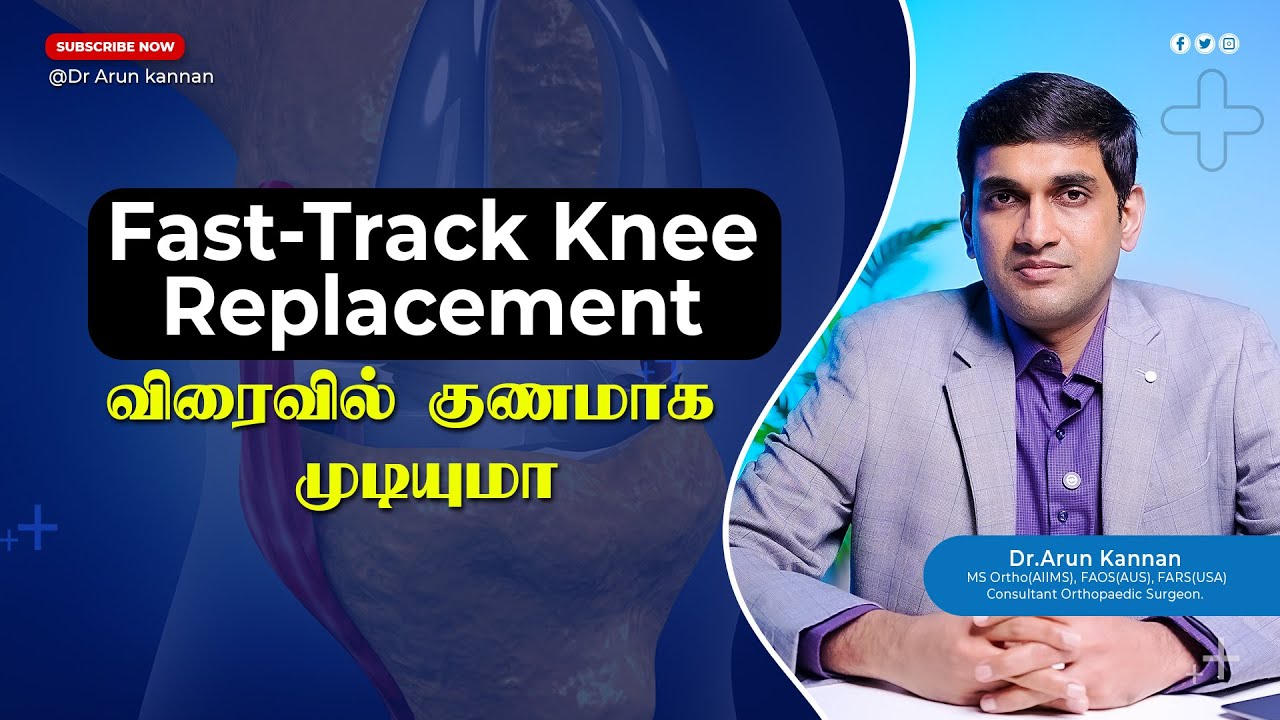 29 July, 2025
29 July, 2025
Fast-Track Knee Replacement Explained: A Revolutionary Approach to Quicker Recovery
Knee pain, especially when caused by severe arthritis or end-stage joint degeneration, can dramatically reduce your quality of life. If you’ve been struggling with chronic knee pain and are considering knee replacement surgery, it’s essential to understand the latest advancements that can make your recovery faster, more comfortable, and more effective. One such breakthrough is the Fast-Track Knee Replacement procedure, a cutting-edge approach that combines minimally invasive surgical techniques, advanced pain management, and optimized rehabilitation protocols to help patients return to normal life sooner.
As an orthopedic surgeon specializing in knee replacements at Apollo Hospitals, Chennai, I have witnessed firsthand how this innovative method transforms patient experiences. In this comprehensive article, I will explain everything you need to know about Fast-Track Knee Replacement—what it is, how it is performed, its benefits over traditional surgery, and who is an ideal candidate for this procedure. Whether you are a patient exploring your options or a caregiver seeking to understand this treatment better, this guide will provide valuable insights into this life-changing surgery.
What is Fast-Track Knee Replacement?
Fast-Track Knee Replacement is a modern surgical concept designed to minimize the trauma to the knee during surgery and accelerate post-operative recovery. Unlike traditional knee replacement procedures, which often involve extensive tissue disruption and longer hospital stays, the Fast-Track method emphasizes:
- Minimally invasive surgical techniques
- Advanced pain management strategies
- Early mobilization and physiotherapy
- Shorter hospital stays and quicker discharge
The goal is to reduce the patient’s discomfort, avoid complications, and enable a faster return to daily activities. This approach has evolved over the past two decades with significant improvements in surgical tools, anesthesia, and rehabilitation methods.
Historical Perspective
About 20 years ago, knee replacement surgery was a longer process both in the operating room and in recovery. Patients typically stayed in the hospital for a week or more, with considerable pain and limited mobility for several weeks post-surgery. The primary focus was on replacing the damaged joint, often using more invasive techniques that required longer healing times.
Today’s Fast-Track approach changes this paradigm by focusing equally on the patient’s comfort and functional recovery, not just the technical success of the implant placement.
How is Fast-Track Knee Replacement Performed?
The Fast-Track procedure is a combination of several advanced methods that work together to optimize outcomes. Here’s a detailed look at the key components of the surgery and recovery process:
1. Surgical Approach: Minimally Invasive Techniques
One of the most critical factors in fast-track surgery is the surgical approach. Traditional knee replacements often involve large incisions and significant disruption of muscles and soft tissues, especially the quadriceps muscle, which plays a vital role in knee movement.
Fast-Track Knee Replacement uses a minimally invasive quadriceps-sparing approach. This means:
- The incision is smaller, reducing tissue trauma.
- The quadriceps muscle is preserved as much as possible, minimizing muscle weakness after surgery.
- This results in less pain, less blood loss, and quicker return of muscle strength.
Minimally invasive surgery also leads to reduced swelling and scarring, which directly contributes to faster healing and mobility.
2. Robotic Assistance in Surgery
Robotic technology is increasingly used in knee replacements to enhance precision. Robots help surgeons in:
- Accurately aligning the implant components.
- Customizing the surgery to the patient’s unique anatomy.
- Minimizing errors and improving implant longevity.
Robotic assistance ensures that the knee replacement is not only less invasive but also optimally positioned for function and durability, which supports quicker rehabilitation.
3. Advanced Pain Management: Multimodal Analgesia
Effective pain control is vital to the success of Fast-Track Knee Replacement. Pain can limit movement, delay physiotherapy, and prolong hospital stays. To address this, a multimodal pain management strategy is employed, involving:
- Local infiltration of a combination of medications directly into the surgical site.
- Nerve blocks to temporarily numb pain sensations for up to two days post-surgery.
- Systemic pain medications tailored to individual needs.
This approach reduces reliance on opioids, decreases side effects, and maintains patient comfort, allowing early mobilization.
4. Early Mobilization and Physiotherapy
In traditional knee replacement surgery, patients often remain immobile for several days. In contrast, Fast-Track Knee Replacement emphasizes getting patients on their feet and walking as soon as possible—often within 24 hours of surgery.
Physiotherapy protocols are designed to:
- Encourage bending and flexing the knee gently to restore range of motion.
- Strengthen the quadriceps and other supporting muscles.
- Improve balance and gait to reduce the risk of falls.
Early physiotherapy not only speeds up recovery but also reduces complications such as blood clots and stiffness.
5. Shorter Hospital Stay and Earlier Discharge
With reduced pain, less tissue trauma, and active physiotherapy, patients undergoing Fast-Track Knee Replacement can often be discharged by the second or third day after surgery. In some cases, especially in Western countries, patients may even be discharged the same day or the evening of surgery.
This early discharge is supported by close outpatient follow-up and home-based rehabilitation programs.
Benefits of Fast-Track Knee Replacement Over Traditional Surgery
The Fast-Track approach offers numerous advantages that significantly improve patient outcomes and experiences. Here are some of the key benefits:
1. Reduced Pain and Improved Comfort
Minimally invasive techniques and multimodal pain management dramatically reduce post-operative pain. Patients experience greater comfort during the critical first days after surgery, making it easier to participate in rehabilitation.
2. Faster Recovery and Mobility
Preserving the quadriceps muscle and encouraging early movement enables patients to regain knee function quicker. This leads to a faster return to daily activities, work, and hobbies.
3. Lower Risk of Complications
Early mobilization reduces the risk of blood clots in the veins—a serious complication that can lead to pulmonary embolism. Additionally, smaller incisions and less tissue damage lower the chance of infections and wound healing problems.
4. Shorter Hospital Stay
Patients benefit from reduced hospital stays, which decreases healthcare costs and minimizes exposure to hospital-acquired infections.
5. Better Long-Term Outcomes
Accurate implant placement using robotic assistance and preservation of muscle function contribute to improved joint stability and implant longevity, enhancing patients’ quality of life for years to come.
Who is the Right Candidate for Fast-Track Knee Replacement?
While Fast-Track Knee Replacement offers significant advantages, it may not be suitable for everyone. Ideal candidates typically include:
- Patients with end-stage knee arthritis or severe knee joint damage that limits daily activities and causes chronic pain.
- Individuals who are medically stable and do not have severe comorbid conditions that could complicate surgery or recovery.
- Patients motivated to participate actively in post-operative rehabilitation and follow care instructions closely.
- Those without significant muscle weakness or deformities that might require more extensive surgical correction.
Each patient’s case is unique, and a thorough evaluation by an experienced orthopedic surgeon is essential to determine the best surgical approach.
Patient Experience and Success Stories
Many patients who have undergone Fast-Track Knee Replacement report remarkable improvements in their quality of life. They often describe:
- Significant reduction in knee pain within days after surgery.
- Ability to walk and climb stairs much sooner than expected.
- Minimal discomfort during physiotherapy sessions.
- Quick resumption of daily routines and hobbies.
These positive outcomes are the result of a well-coordinated surgical and rehabilitation plan that puts the patient’s comfort and functional recovery first.
Conclusion
Fast-Track Knee Replacement represents a major advancement in orthopedic surgery, combining minimally invasive techniques, robotic precision, multimodal pain management, and early rehabilitation to offer patients a faster, safer, and more comfortable path to recovery. If you or a loved one is battling severe knee pain and considering knee replacement, exploring this innovative approach could make a significant difference in your surgical experience and long-term joint health.
Consulting with a skilled orthopedic surgeon who specializes in Fast-Track and robotic knee replacements is the first step toward finding the best solution tailored to your needs. With the right care, you can look forward to regaining mobility, reducing pain, and returning to the activities you love.
Frequently Asked Questions (FAQs)
What is the main difference between traditional and Fast-Track Knee Replacement?
Traditional knee replacement typically involves larger incisions, more muscle disruption, longer hospital stays, and slower recovery. Fast-Track Knee Replacement uses minimally invasive techniques, advanced pain control, and early physiotherapy to speed up recovery and reduce discomfort.
How soon can I walk after Fast-Track Knee Replacement surgery?
Most patients are encouraged to start walking within 24 hours after surgery, with assistance from physiotherapists. Early mobilization is a key part of the Fast-Track protocol.
Is Fast-Track Knee Replacement suitable for elderly patients?
Age alone is not a contraindication, but the overall health status and ability to participate in rehabilitation are considered. Many elderly patients benefit from Fast-Track surgery if they are medically stable.
Does robotic assistance make the surgery safer?
Robotic technology enhances precision in implant placement, which can improve joint function and implant longevity. It also helps minimize tissue damage, contributing to a safer and more effective surgery.
What kind of pain management is used in Fast-Track Knee Replacement?
The pain management strategy involves a combination of local anesthetics, nerve blocks, and systemic medications tailored to each patient. This multimodal approach controls pain effectively while reducing reliance on opioids.
How long will I stay in the hospital after Fast-Track Knee Replacement?
Hospital stays are typically shorter, with discharge often possible by the second or third day after surgery. Some patients may even be discharged the same day, depending on individual circumstances and healthcare protocols.
Will I need physiotherapy after the surgery?
Yes, physiotherapy is an essential part of recovery. Early and consistent physiotherapy helps restore knee movement, strengthen muscles, and improve balance and gait.
Are there any risks associated with Fast-Track Knee Replacement?
As with any surgery, there are risks such as infection, blood clots, and implant-related issues. However, the Fast-Track approach aims to minimize these risks through meticulous surgical technique and early mobilization.
Where can I get Fast-Track Knee Replacement surgery?
Many advanced orthopedic centers and hospitals offer Fast-Track Knee Replacement, especially those equipped with robotic surgery technology and experienced surgeons. It’s important to choose a center with a comprehensive care team experienced in this approach.
How long does the Fast-Track Knee Replacement surgery take?
The duration varies depending on the complexity of the case, but typically the surgery is completed within 1 to 2 hours. Robotic assistance can streamline the procedure and improve accuracy.
About the Author
Dr. Arun Kannan is a leading orthopedic surgeon specializing in robotic knee and hip replacements at Apollo Hospitals, Chennai. With advanced qualifications including MS ORTHO (AIIMS), FAOA (Australia), and FARS (USA), Dr. Kannan is dedicated to providing cutting-edge surgical care and improving patient outcomes through innovative techniques such as Fast-Track Knee Replacement.
For more information or to schedule a consultation, you can visit Jayam Ortho Care in Kodambakkam, Chennai, or connect through social media and hospital contacts.

